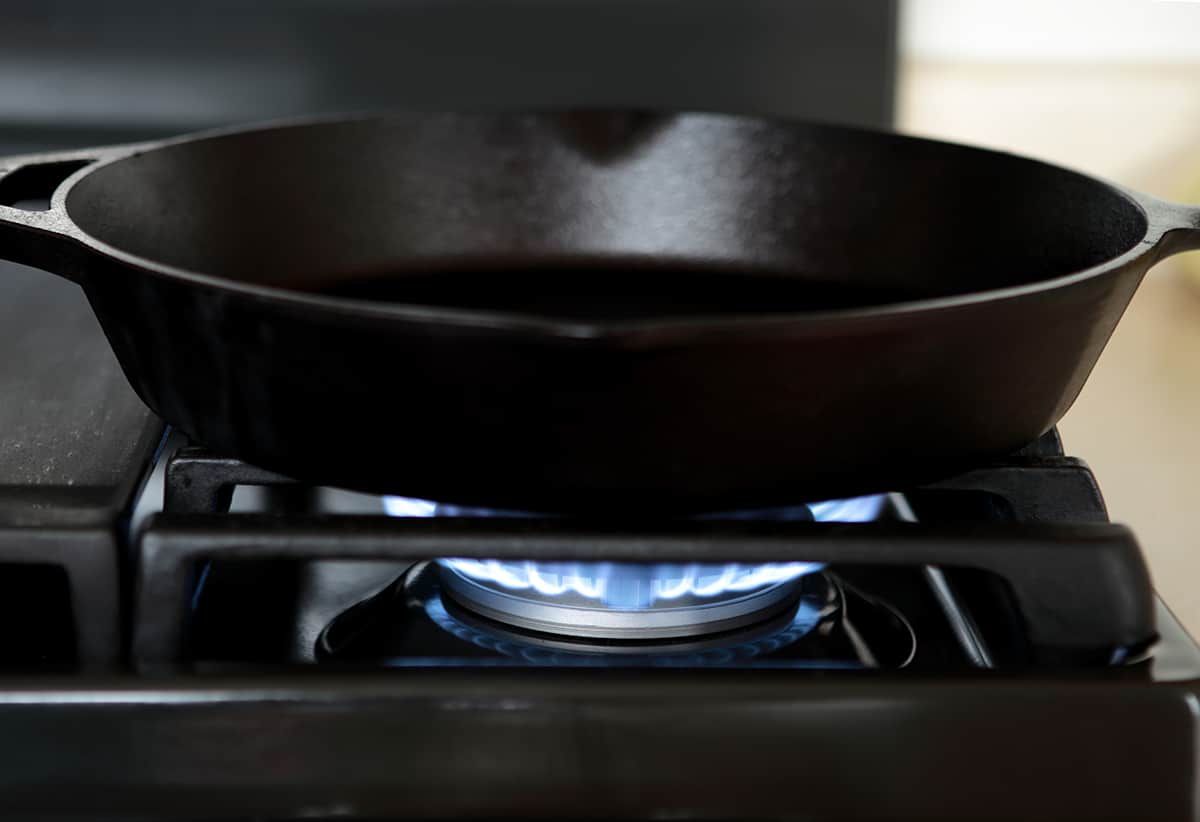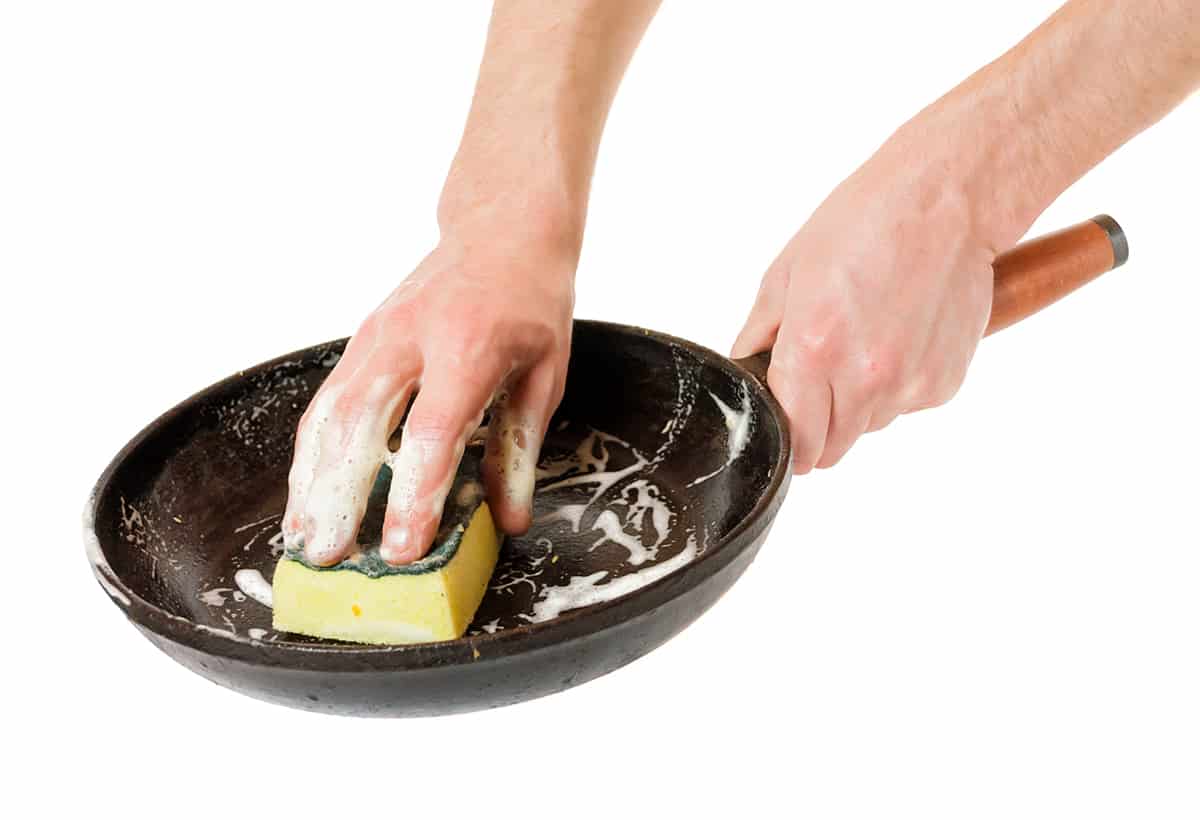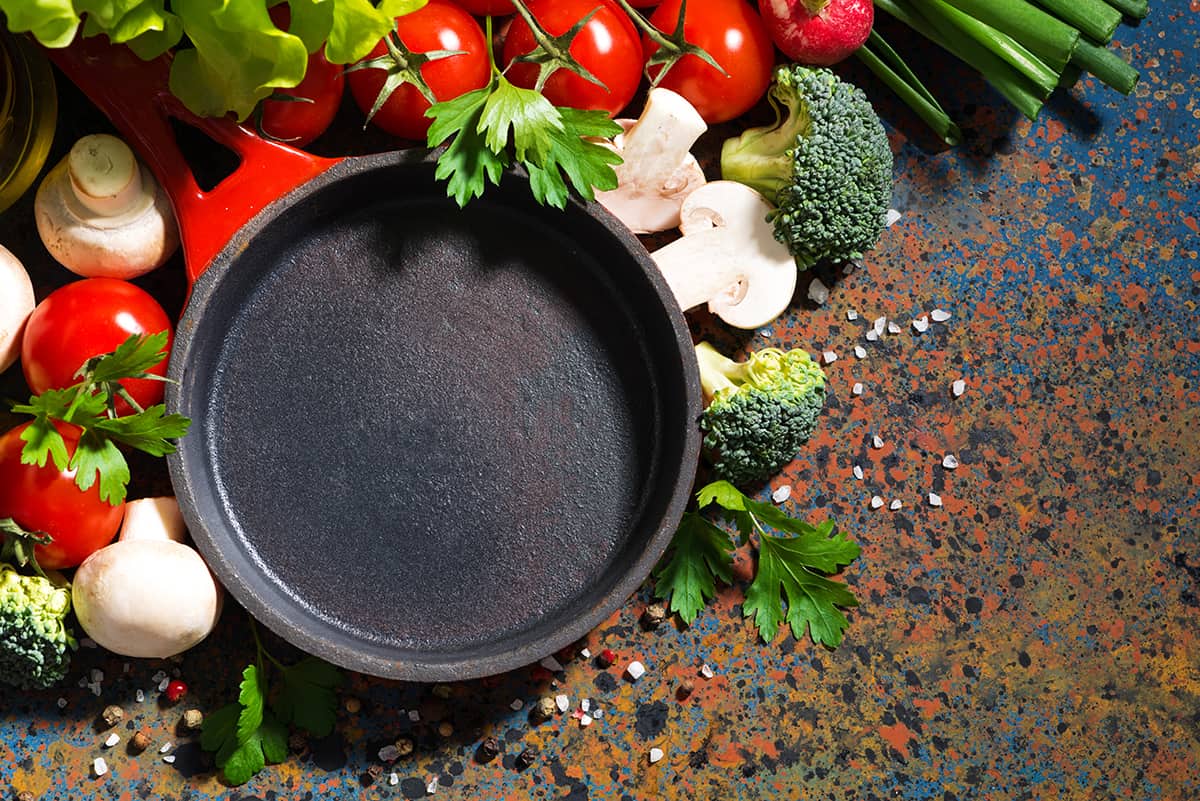One of the first things you should do when you take home a brand-new cast-iron skillet is to season it. Seasoning produces a non-stick surface, which is essential for sliding food right off the pan. Traditionally, seasoning is done by popping a pan in a super-hot oven, but if you don’t have access to one?
You can season a cast-iron skillet on the stove. Here’s how you do it:
- Heat the pan on medium heat
- Rub food-grade oil in the pan
- Raise the heat to high heat and continue cooking until the oil smokes
- Remove the pan from the heat to cool down
- Rub oil in and around the pan every 5 to 15 minutes until the pan is at room temperature
In this guide, I’ll explain why seasoning is important, how to season cast iron without an oven, and how to maintain the seasoning.
What Is Seasoning?

If you’re a total newb at cooking, you’ve probably heard about how important it is to season your pans. But what exactly does seasoning mean?
Seasoning creates a non-stick layer on cookware. It’s done by heating a pan with oil at high heat and allowing the oil to seep into the invisible crevices on the pan’s surface. The resulting layer of carbonized oil creates a slippery surface, so food slides right off the pan.
The cookware materials that should be seasoned before use are as follows:
- Cast iron
- Carbon steel
- Hard-coat aluminum
- Tin
In addition to creating a non-stick surface, seasoning can protect your cookware from corrosion. With proper seasoning, your cast-iron pan can be passed down from generation to generation without showing a single sign of brownish-red rust.
How to Season Cast Iron Without Oven
Traditionally, seasoning cast iron and other materials is done by popping the pan in an oven. However, if you don’t have an oven, or if your oven doesn’t reach 450°F, then you can try seasoning cast iron on a stovetop.
- Before we get started, here’s a checklist of what you’ll need:
- Unseasoned cast-iron pan
- At least half a cup of food-grade oil (the higher to smoke point and the more neutral the taste, the better)
- At least one roll of paper towels
- A stove
- A pair of tongs
- Oven mitts or pot holders
After collecting all the tools and materials you need, we can get started.
- Turn your stove on to medium heat.
- Place your cast-iron pan on the stove burner.
- Pour the oil into the pan. Do not flood the pan in oil; a quarter-inch of oil should be fine.
- While the pan is heating up, fold a paper towel sheet and push the oil all over the pan. Make sure you coat the sides and the rim with oil. Coating the handle is optional.
- Pour more oil into the pan and repeat the previous step. Remember not to flood the pan in oil.
- While the pan is heating up, move the pan around to continue coating the sides with oil.
- Increase your stove to high heat.
- Leave the pan alone until the oil starts to smoke.
- Continue heating the pan for 3 minutes before turning off the heat.
- With the heat off, wipe the oil with paper towels all over the pan every 5 minutes.
- Repeat the previous step until the pan has come down to room temperature.
While the pan is cooling down, the excess oil will seep into the empty pores and crevices. At the end of the seasoning process, there should be significantly less oil in the pan than the amount you started with. Dump out the excess oil, and your cast-iron pan should be fully seasoned.
After seasoning, place the pan in a sink and rinse it with warm water. Do not use soap when cleaning a seasoned pan since the soap can strip away the layer of carbonized oil.
When the pan is dry, you can immediately begin using it to cook. If done properly, you won’t need to add too much oil or butter to create a non-stick surface.
How to Clean a Seasoned Pan

Taking care of a cast-iron pan involves more than just seasoning it and hoping for the best. Here’s what you need to do to take care of your cast-iron pan without stripping the seasoning.
- Let the pan cool down to room temperature.
- Place the pan on a stove and add a few drops of mild dish soap.
- Fill the pan with warm or hot water and use the soft side of a sponge to massage the pan’s surface.
- Rinse the pan and dry it with a paper towel.
- To remove stuck-on bits, add a handful of kosher salt to the pan and use the soft side of a sponge to massage the salt into the leftover food soil.
- Heat the pan on medium heat and pour in 2 tablespoons of food-grade oil.
- When the oil begins to smoke, turn off the heat and let the oil seep into the empty pores and crevices.
Please note that this method of caring for a cast-iron skillet only works when the skillet is already seasoned. So, if you inherited an unseasoned pan from your folks, make sure to season it before use and clean it after each use.
Stove vs. Oven Seasoning
If you can season cast iron on a stovetop, why would you even need to use an oven to season the pan in the first place?
While stovetop seasoning is possible, it’s not optimal. Here’s why:
- Ovens distribute heat evenly. The burner on your stove may be slightly unlevel, which may result in cool spots when seasoning your pan. This can lead to uneven seasoning.
- You can season the entire pan. Even though food shouldn’t touch the pan’s handle, it’s generally a good idea to season the entire thing. If you wanted to season the handle on a stovetop, you would need to move the place the handle onto the stove’s burner, which isn’t advisable.
- You don’t have to handle a scorching hot pan. The pan will spend the entire seasoning process inside the oven. You don’t have to move it around and risk burning your hand.
That said, cleaning a pan using the oven-less method described above is the simpler method. You can clean a cast-iron pan in your oven, but it takes more time and more fuel to do.
Can You Season Cast Iron on an Electric Stove?

Yes, you can. In fact, you can even do it on an induction stove! However, I wouldn’t recommend it, especially on an induction stove.
As fantastic as electric stoves are, their burners will usually focus heat onto the center of the pan. The only reliable way to heat up the pan is to wait for the heat to transfer from the center to other sections of the pan.
A gas stovetop is ideal for seasoning since you can twist and turn the pans to heat up every section. The ideal gas stove to use is a high-pressure burner, which is usually not something people have in their homes. That said, a regular-burner gas stove will be fine—it just takes considerably longer to heat up the pan.
How to Remove Rust from a Cast-Iron Pan
If your cast-iron pan shows signs of rust, you need to remove the dark-brown spots before seasoning it. Here’s what you can do:
- Add a handful of kosher salt to the pan.
- Scrub the pan with a steel wool pad until the rust comes off.
- Rinse the pan.
When the rust is gone, go ahead and season it. Don’t forget to clean the seasoned pan using the method described above!






